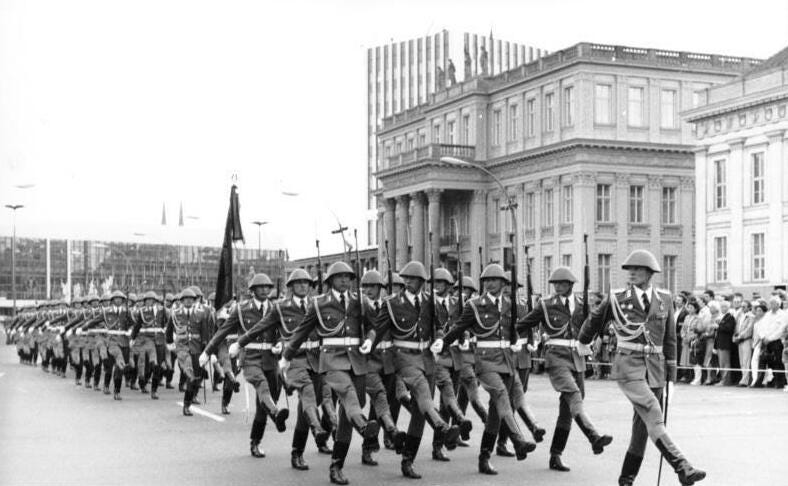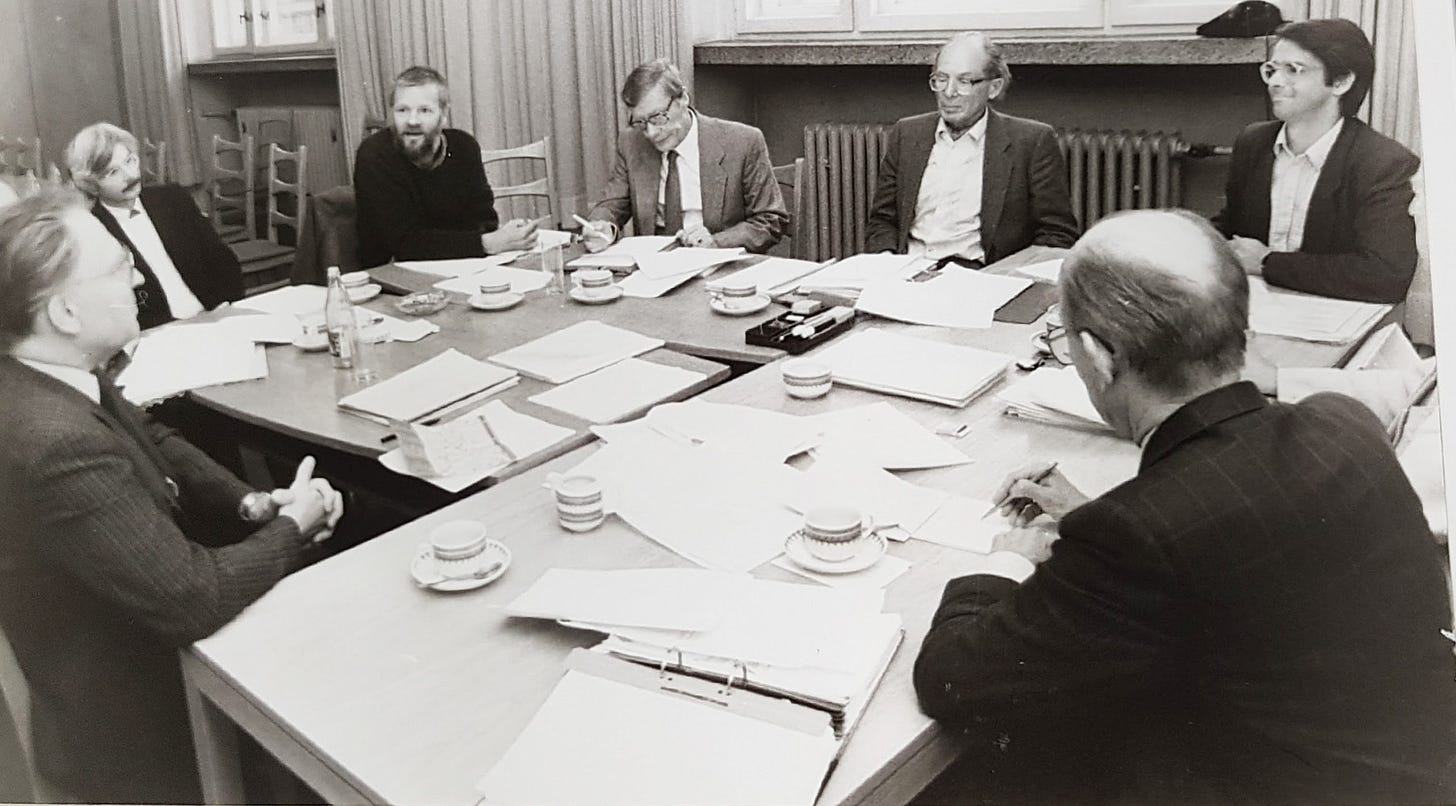On military parades, past and present
I attended a military parade in East Berlin in 1985; it shaped how I viewed the recent parade in Washington, D.C.

The date was 8 May 1985.
I was in Berlin to visit the Deutsche Staatsbibliothek (the German State Library), on the grand avenue Unter den Linden in what was then East Berlin. I had made a trip to Germany to consult documents pertinent to a musical edition I was preparing, and the most important manuscript sources were in the Deutsche Staatsbibliothek.
My hotel was a cheap Pension in the western sector of the city and each day I arose early to cross the checkpoint from West to East, making my way on foot through the city to the library. On this particular day—a Wednesday—when I arrived the library was closed, and I didn’t know why.
I had observed the red banners with white lettering spanning Unter den Linden since my first trip across the border. There were many that read “40. Jahre Befreiung vom Hitler Faschismus” (40 years of freedom from Hitler fascism). Other banners had patriotic slogans as well as the hammer and compass symbol of the country, referring in various ways to “unser DDR” (our German Democratic Republic, or East Germany). The banners had been hung for a major celebration marking the formal end of hostilities in Europe in 1945, but I was too focused on my own work to note the date.
I left the closed library building and walked toward the city centre, in the direction of the Alexanderplatz, encountering a small group of people lingering near the Neue Wache (New Guardhouse)—a war memorial featuring an eternal flame. I enquired of them what was happening and they explained that there would be a parade to memorialise the end of the World War II. Since the Neue Wache would gain special attention during the parade, they encouraged me to remain with them to have an optimal view of the parade. We made small talk and it was clear that among them were ordinary citizens as well as a few true political believers in the DDR. Eventually we were moved some distance away by military officers since an official reviewing group would assemble there. As we waited an enormous crowd gathered on the sidewalks of the avenue.
My recollection is that the parade started with soldiers from the ground forces of the Volksarmee (People’s Army) marching down the avenue before us in the direction of the Brandenburg Gate. I was struck immediately by the sight as they approached us. At the head of the column was a flag-bearer carrying a flagpole from which hung the ornate standard representing the regiment. The marching was disciplined and flawless. The uniforms seemed reminiscent of those I associated with the German army of World War II, some even wore jodhpurs. The sight was eerily similar to images in newsreels I had seen from the Hitler period of German soldiers marching down this very same avenue.
As the first column of soldiers arrived at the Neue Wache, an officer shouted a command (Stechschritt!) and the soldiers began to goose step. Again, the site was familiar from old newsreel films I’d seen, but I had never experienced the impression it creates in person. Visually, for me, the primary effect was to evoke those old images of military parades during the period of the Third Reich. What I was unprepared for was the sound: the loud and intimidating “crack” as the boots of an entire regiment simultaneously met the ground. It literally raised the hair on the back of my neck. It was not from excitement, it was from the visceral feelings it evoked of what a disciplined military force is capable of—and East Berlin remained at that time full of destroyed buildings that provided ample evidence of it.
The parade seemed endless. It included mechanised divisions with Russian T-72 tanks and other armoured vehicles. Military bands. And high-ranking East German and Soviet officers marching in solidarity. Some might have felt pride; I felt nervous and intimidated. The crowd of observers remained generally quiet throughout.
In the years thereafter I had many further professional contacts with people and institutions in the DDR. I served for some decades on the Commission Mixte of a German Verein—a kind of non-profit association which, in this case, promoted a major international music project. During one gathering of this group in East Berlin, a few months after I had experienced the military parade in 1985, the meeting was interrupted by a group of men who identified themselves as being from a Berlin press organisation. They took photographs and recorded the names of all present. When they left, the East German host of the meeting said quietly, “Staatssicherheitsdienst” (better known as the “Stasi,” the country’s secret police service). I’ve never known for sure whether this was a joke, but everyone present laughed, uncomfortably. (We all eventually received a photographic print of the entire group by post.)
Later, before the reunification of Germany, I had spent sufficient time in the DDR to observe the general circumstances of the citizens there. Fruit such as citrus or bananas was virtually unknown in the markets and, as such, made highly appreciated gifts when travelling from West to East. There seemed to be shortages of everything. Everything seemed of poor quality and designed to be ephemeral, from paper to automobiles to the new Soviet-style buildings. Nothing could be accomplished without waiting in some lengthy queue. Life seemed grim and colourless through my Western eyes.
It is, I believe, circumstances such as these that create the need for a government to assert its power and control through a parade of military force.
When I first heard of the planned military parade in Washington D.C., my thoughts returned immediately to my experience in Berlin that spring of 1985.
The parade had taken place in a divided city of a divided country. East Germany—the DDR—was a country closely aligned with other autocratic and socially repressive nations. A country whose currency had no tangible value in the international currency markets. A country bereft of wealth and prosperity, led by an autocratic and repressive government that exercised control over nearly every aspect of civic life. A country that used the anniversary of the end of the war that had destroyed it not to recall the suffering and honour the dead; rather it used the occasion to reassert military strength—an attempt to mask the pervasive weakness of the society with a military show of force. And it was a country isolated from the world around it through a particular introspective nationalism, as well as physical and policy barriers.
The June 16th military parade in Washington, D.C. took place in a divided country, too. One where ideological notions of what it means to be a Democrat or Republican divides people. Where states are divided into “blue” or “red” depending on their populations’ voting patterns. Where a creed of nationalism and isolationism rejects traditional alliances in favour of linkages with autocratic and repressive regimes. Where the national currency and the nation’s international influence are on the decline. Where the government seeks ever greater control of the population’s personal choices and domestic lives through divisive policies. Where the personal data of residents is aggregated and analysed to facilitate the expulsion of those who, in the words of the President, are “poisoning the blood of our country.” Where the gap between the most wealthy and the poorest citizens has reached an unprecedented distance. And where principles of free speech and privacy are eroding in the face of intimidation and with the collusion of a powerful oligarchy.
I left Berlin in 1985 with a deep impression of what a military parade looks like and means. It is hard to see the recent parade in the capital of the United States in some different light.
Still, what struck me this: the parade in D.C. lacked the discipline and tempo of what I witnessed in Berlin, and it did not create nearly the impression of force and control. Rather, the shuffling gait of many soldiers appeared to mock the disciplined marching in which they had inevitably been drilled; the slow pace and wide distances between motorised vehicles telegraphed disengagement; and the sight of overweight enlisted men leisurely navigating an army jeep down a city street seemed almost satirical. Poor attendance and many early departures amplified that impression.
The message of the parade seemed to be one of half-hearted and coerced cooperation, not a projection of national or presidential power. It is that which gives me hope.





I too was relieved that the parade was toned-downed from being an intimidating display to being more of a celebration of the history of America's citizen army. I think there is still hope!
Having been in the U.S. Army myself, serving in Germany 1971-72 as a clarinetist with the 3rd Infantry Division Band, I will never forget brief moments of visceral sting of former DDR repression that I felt as I took the military duty train across East Germany to West Berlin. The train stopped at the border to switch engineers and the DDR soldiers coming through the train to inspect our military IDs. Then, in Berlin, being in the physical presence of the Berlin Wall at the Brandenburg Gate with the East German machine gun towers. --It was interesting to hear your experience in the DDR.
Having been in the Army myself, I am pretty sure that the parade on June 14th in DC was toned down intentionally and precisely--I don't think the U.S. military would leave these details to chance.
Great piece. You said that you felt intimidated by the parade in East Germany. I suspect that was precisely the point. I also suspect that Trump wanted his parade to intimidate; his rhetoric beforehand certainly suggested as much. But it failed rather pathetically at achieving that. I'm not sure if the failure was part of a plot on the part of the soldiers, as some are suggesting, or a more general expression of the American mood. But the failure is nonetheless very reassuring.